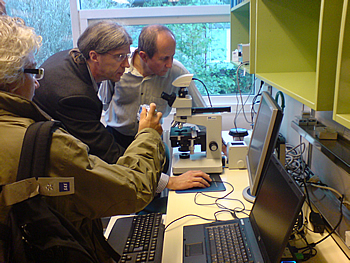
5th Meeting of the Panel on Quarantine Nematodes
Alnarp, SE, 2007-09-11/14
The Panel on Quarantine Nematodes met at the Swedish University of Agricultural Sciences (SLU), Departement of Crop Science, on 2007-09-11/14, at the kind invitation of Ms Manduric. The Panel continued its work on the preparation of diagnostic protocols. To date, five diagnostic protocols have been published: PM 7/4 Bursaphelenchus xylophilus; PM 7/5 Nacobbus aberrans; PM 7/39 Aphelenchoides besseyi; PM 7/40 Globodera pallida & G. rostochiensis and PM 7/41 Meloidogyne chitwoodi & M. fallax.
The comments received from Country consultation on the Diagnostic protocol for Heterodera glycines were reviewed and the protocol will be presented for final adoption in 2008.
The protocols on Ditylenchus destructor & Ditylenchus dipsaci, Radopholus similis and the revision of PM 7/41 Meloidogyne chitwoodi & M. fallax were reviewed and considered ready to be sent for Country consultation in 2008.
The protocol for Xiphinema americanum (sensus lato) was considered ready for country consultation but should first be presented to the Panel on Diagnostics in May 2008 along with a first draft of the protocol for Hirschmanniella spp.
A first revision of PM 7/5 Nacobbus aberrans to include a molecular method was also studied at the Panel. It was considered that other parts of the protocol needed revision. The text will consequently be revised more globally and presented at the next Panel meeting in 2009.
The Panel was informed of the latest developments concerning the EPPO programme on quality assurance and accreditation. It discussed the difficulty of finding good reference material in nematology and supported the development of an EPPO standard on reference material.
The Panel also considered that the following nematodes should be added to the EPPO Alert List:
- Belonolaimus longicaudatus. This polyphagous nematode might become a problem for Southern member countries, especially in sandy soils.
- Meloidogyne minor. A joint Dutch/British PRA concluded that potato, rotation pasture and managed turf were at risk, and that the species complex was not fully characterized and could be easily confused with species such as M. chitwoodi. Surveys are required to identify the distribution in the EU.
More information should be provided to the EPPO Secretariat on species of potential concern for maize including Heterodera zeae, Punctodera chalchoensis, Paratrichodorus minor and Paratrichodorus porosus.Finally the Panel finalized the procedure for official control of Heterodera glycines which should be presented for final adoption in 2008. The Panel will next meet in 2009 in Firenze, (IT) the date still needs to be confirmed.


